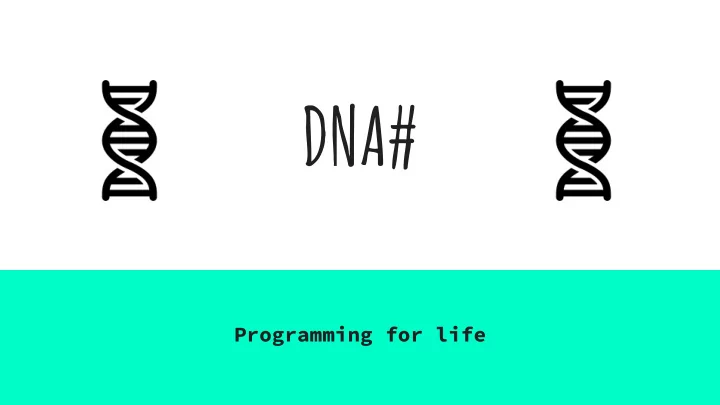

DNA# Programming for life
WHO ARE WE? GURUS
MOtivations Scientists and geneticists are seeking to “engineer” DNA ● and develop complex computational tools Only tools to process genetic data are libraries within ● other languages (e.g. BioPython) Large overhead ○ Low customizability ○ DNA is rapidly being explored as an alternate form of ● data storage “Capacity approaching DNA storage” - Yaniv Erlich (Columbia ○ University) et al. “Microsoft experiments with DNA storage: 1,000,000,000 TB in a gram” ○ - Peter Bright
First...a little bit of biology
DNA# In a slide
Data Types Native types from C ● int, bool, char, ○ Complex types ● Strings, Arrays ○ DNA specific types ● DNA, RNA, Nuc, Pep, AA ○
Some friendly inbuilt operations DNA specific operators ● DNA -> :transcribe ○ RNA +> : translate ○ String/DNA friendly operations ● Overloaded + operator for string types ○ .length function to get size of complex types and arrays ○ Generalized print function ● Can print any type! ○
Key Features Statically typed ● Statically scoped ● Fluid data type conversion (e.g. DNA -> RNA -> peptides) ● Natively supported string functions ( string1 + string2) ● No global variables ● All memory stored on stack ●
Third Party Software
Abstract Syntax Tree
DNA# Architecture - Built-in C lib & Elegant ext_func_lst Our language has one built-in C-lib, and a series of helper functions. It is very easy to use C-library. There are only three steps to add one C-function. (1) Add your function in c_lib.c. (2) Register the new function in ext_func_lst table. (3) Make project, then magic happens. - Pseudo-Main Since DNA# is a script style language, it starts at the first line of *.dnas file. In ‘codegen.ml’, we build a pseudo-main function to collect all stmts outside other defined functions and make it the main func in LLVM.
Testing Suite Unit Testing ● Identifiers (if, for, while) ○ Standard, primitive, and complex data types (dna, rna) ○ Control flow ○ Functions ○ Literals (Nuc, AA, Integer, Double, Bool, Character, String) ○ Integration Testing ● ● System testing ●
DEMO Find longest subsequence amongst two DNA sequences and ● print protein that would be generated Mutations ○ DNA alignment and sequencing ○
Applications DNA encoding (Huffman encoding, DNA fountain, etc.) ● Yaniv Erlich/NY Genome Center ● Still using biopython and hacked together tools with ● large overhead (personal experience) iGEM and personal experience with that ●
Future Directions Optimizing the transcribe/translate using encoding ● schemes (e.g. DNA Fountain, Huffman) Supporting variable nucleotides and file types ● Supporting addition of libraries (e.g. a file i/o library ● for different file formats) Incorporating type associated global constants, such as ● weight, to make computation easier
Questions
References Funk Programming Language Dice Programming Language OCaml Documentation
Recommend
More recommend